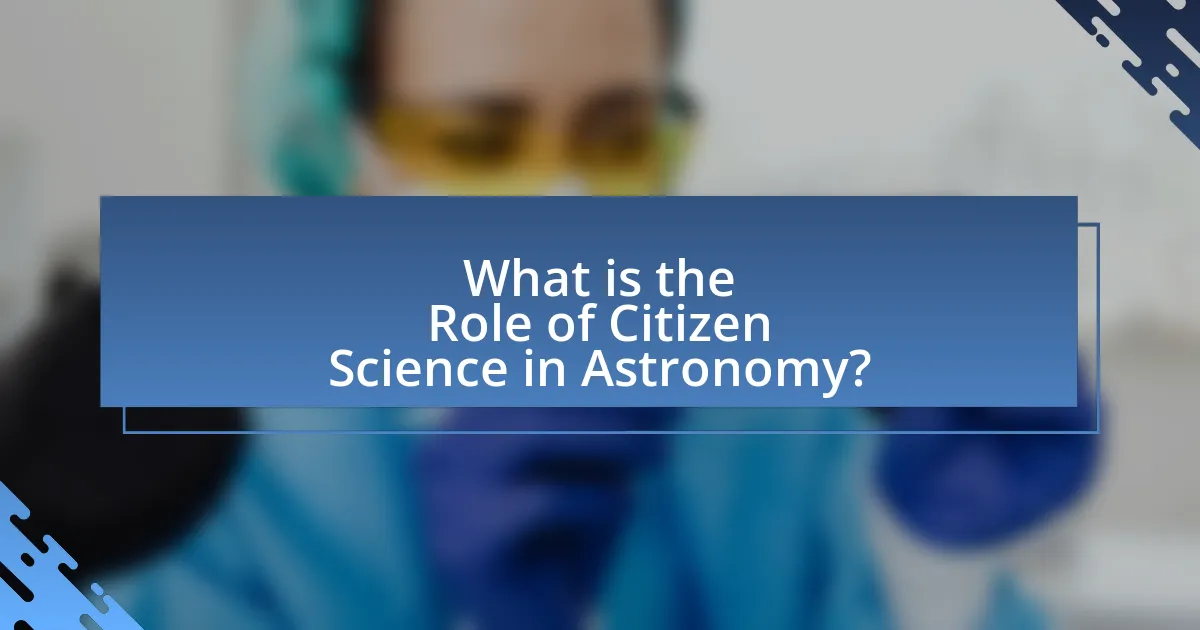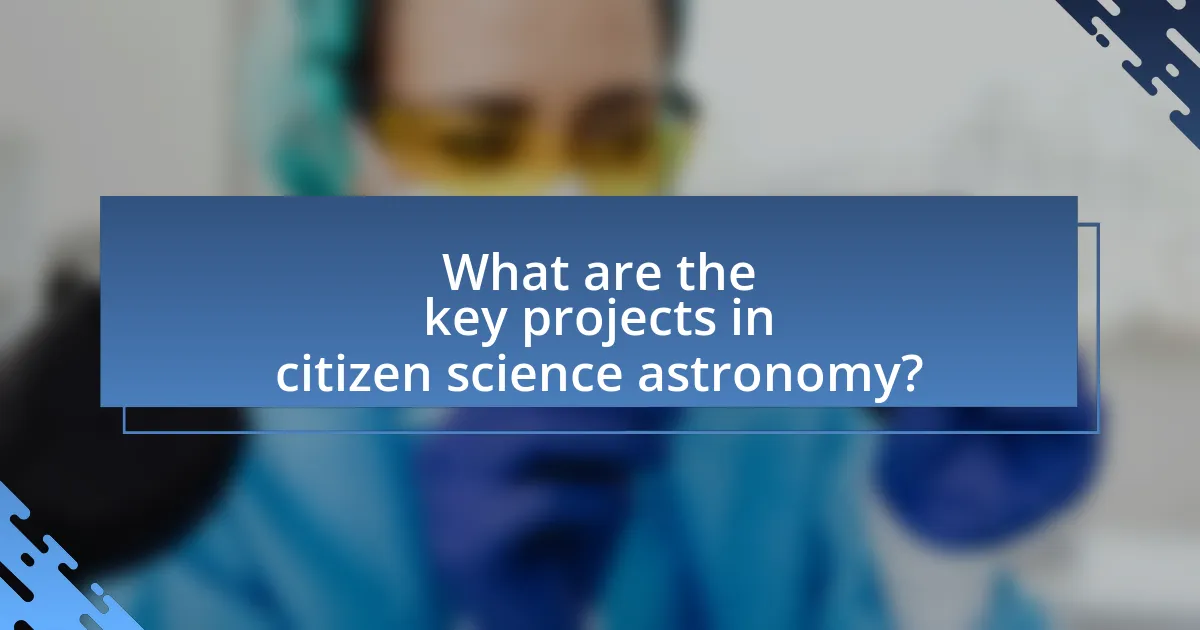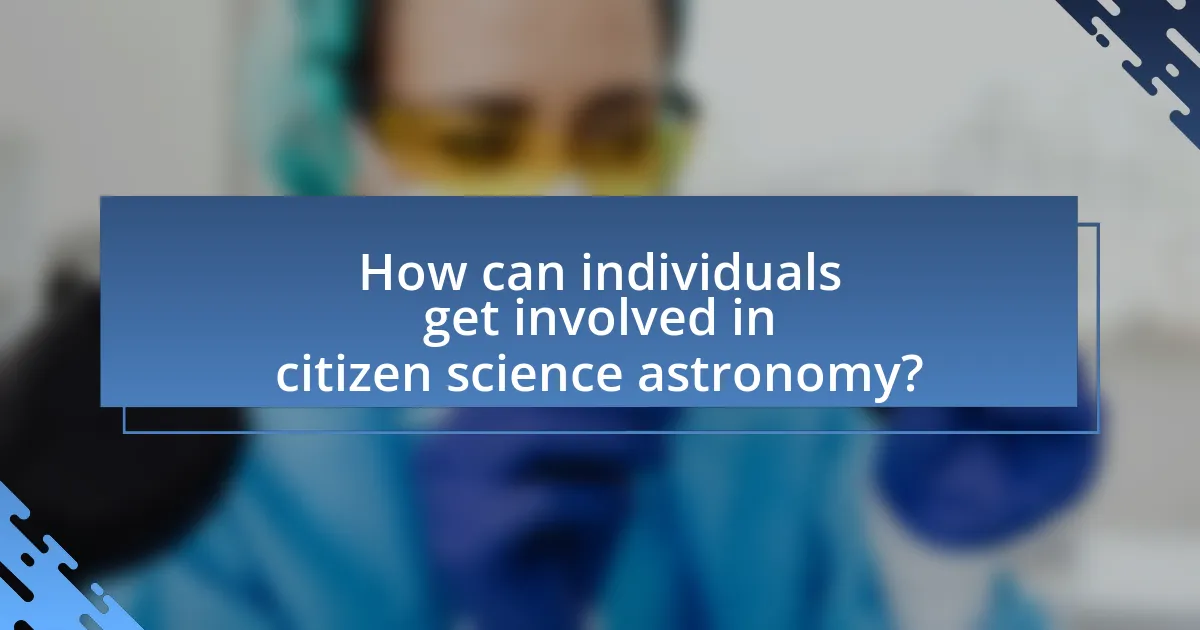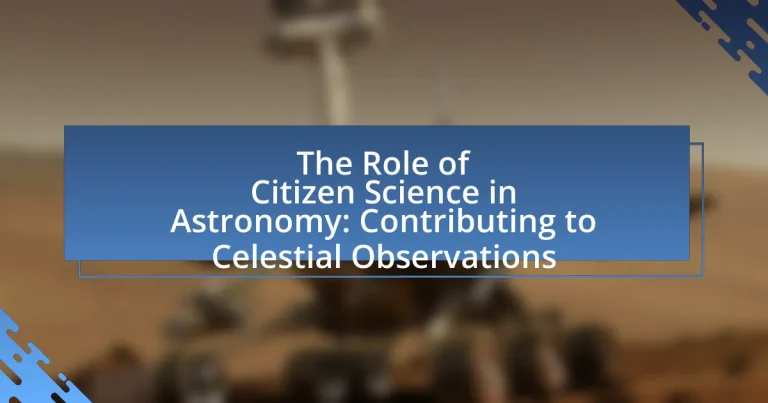Citizen science plays a vital role in astronomy by allowing non-professionals to engage in data collection and analysis, thereby enhancing astronomical research. This collaborative approach has led to significant discoveries, such as the identification of new celestial objects and the classification of millions of galaxies through projects like Galaxy Zoo and Planet Hunters. Citizen scientists contribute to various celestial observations, including monitoring variable stars and tracking asteroids, while overcoming challenges related to data quality and access to resources. The involvement of the public not only accelerates research but also democratizes science, fostering greater interest and understanding of astronomy.

What is the Role of Citizen Science in Astronomy?
Citizen science plays a crucial role in astronomy by enabling non-professionals to contribute to data collection and analysis, thereby expanding the scope of astronomical research. This collaborative approach allows amateur astronomers to assist in tasks such as monitoring variable stars, discovering new celestial objects, and analyzing large datasets from telescopes. For instance, projects like Galaxy Zoo have engaged thousands of volunteers in classifying galaxies, leading to significant discoveries and insights into galaxy formation. The involvement of citizen scientists not only accelerates research but also democratizes science, making it accessible to a broader audience.
How does citizen science contribute to celestial observations?
Citizen science significantly enhances celestial observations by enabling non-professionals to collect and analyze astronomical data. This collaborative approach has led to the discovery of new celestial bodies, such as the identification of over 1,000 exoplanets through projects like Planet Hunters, where volunteers classify light curves from stars. Additionally, citizen scientists contribute to large-scale surveys, such as the Sloan Digital Sky Survey, which has mapped millions of celestial objects, providing invaluable data for researchers. The involvement of the public not only increases the volume of data collected but also fosters a greater interest in astronomy, as evidenced by the participation of thousands in initiatives like Galaxy Zoo, where users classify galaxy shapes, contributing to our understanding of galaxy formation and evolution.
What types of celestial observations can citizen scientists participate in?
Citizen scientists can participate in various types of celestial observations, including monitoring variable stars, tracking asteroids, and classifying galaxies. These activities allow individuals to contribute valuable data to ongoing astronomical research. For instance, projects like the American Association of Variable Star Observers (AAVSO) enable citizen scientists to observe and report on the brightness of variable stars, which helps in understanding stellar behavior. Additionally, platforms like Zooniverse facilitate the classification of galaxy images, aiding in the study of galaxy formation and evolution. Such contributions have been instrumental in expanding the scope of astronomical research and enhancing data collection efforts.
How do citizen scientists collect and analyze astronomical data?
Citizen scientists collect and analyze astronomical data primarily through the use of telescopes, software applications, and online platforms designed for data sharing and analysis. They often participate in organized projects that provide specific guidelines and tools for observing celestial events, such as transits of exoplanets or variable star monitoring. For instance, platforms like Zooniverse allow volunteers to classify images from telescopes, while projects like Galaxy Zoo enable them to categorize galaxies based on their shapes.
The analysis process typically involves comparing their observations with existing astronomical databases and using statistical methods to identify patterns or anomalies. This collaborative approach has led to significant discoveries, such as the identification of new exoplanets and the tracking of supernovae, demonstrating the effectiveness of citizen science in contributing to professional astronomical research.
Why is citizen science important in the field of astronomy?
Citizen science is important in the field of astronomy because it significantly enhances data collection and analysis through the involvement of non-professional astronomers. This collaborative approach allows for the monitoring of celestial events, such as supernovae and variable stars, which would be challenging for professional astronomers to track alone due to the vastness of the sky. For instance, projects like Galaxy Zoo have engaged thousands of volunteers to classify galaxies, resulting in the analysis of millions of images and contributing to our understanding of galaxy formation and evolution. Such contributions demonstrate that citizen scientists can effectively augment professional research efforts, leading to discoveries that might not have been possible otherwise.
What are the benefits of involving the public in astronomical research?
Involving the public in astronomical research enhances data collection, increases public engagement, and fosters scientific literacy. Citizen scientists contribute to large-scale projects, such as the Galaxy Zoo, where volunteers classify millions of galaxies, significantly accelerating research that would take professional astronomers much longer to complete. This collaboration not only enriches the data pool but also cultivates a sense of community and shared purpose among participants, as evidenced by studies showing that public involvement in science leads to greater interest in STEM fields. Furthermore, engaging the public in astronomy helps demystify scientific processes, making complex concepts more accessible and encouraging lifelong learning.
How does citizen science enhance the understanding of celestial phenomena?
Citizen science enhances the understanding of celestial phenomena by enabling large groups of non-professional astronomers to contribute data and observations, which increases the volume and diversity of astronomical research. For instance, projects like Galaxy Zoo allow volunteers to classify millions of galaxies, leading to significant discoveries about galaxy formation and evolution. This collaborative effort not only accelerates data collection but also democratizes scientific inquiry, allowing insights from varied perspectives and experiences. Studies have shown that citizen science projects can lead to findings that are comparable to those produced by professional astronomers, thereby validating the contributions of amateur scientists in advancing our knowledge of the universe.

What are the key projects in citizen science astronomy?
Key projects in citizen science astronomy include Galaxy Zoo, which allows volunteers to classify galaxies based on their shapes, and Zooniverse, a platform hosting various astronomy projects where participants can contribute to data analysis. Another significant project is the Planet Hunters initiative, where citizens help identify exoplanets by analyzing light curves from stars. These projects have collectively engaged thousands of volunteers, leading to significant discoveries, such as the identification of new galaxy types and the confirmation of numerous exoplanets, demonstrating the impactful role of citizen scientists in advancing astronomical research.
Which notable citizen science projects have made significant contributions?
Notable citizen science projects that have made significant contributions include Galaxy Zoo, which has engaged thousands of volunteers in classifying galaxies, leading to discoveries such as the identification of new galaxy types. Another project, the Planet Hunters, has allowed citizen scientists to identify exoplanets by analyzing light curves from stars, contributing to the understanding of planetary systems. Additionally, the American Association of Variable Star Observers (AAVSO) has utilized amateur astronomers to monitor variable stars, providing valuable data for professional research. These projects demonstrate the impactful role of citizen science in advancing astronomical knowledge.
What methodologies do these projects employ for data collection?
Citizen science projects in astronomy employ methodologies such as crowd-sourced data collection, remote sensing, and participatory observation. These methodologies enable volunteers to contribute to celestial observations by utilizing their own equipment or accessing online platforms to analyze astronomical data. For instance, projects like Galaxy Zoo allow participants to classify galaxies based on images provided by telescopes, demonstrating the effectiveness of crowd-sourcing in gathering large datasets. Additionally, platforms like Zooniverse facilitate collaboration among citizen scientists, enhancing the volume and diversity of data collected.
How have these projects impacted the scientific community?
Citizen science projects in astronomy have significantly enhanced the scientific community by increasing data collection and analysis capabilities. These initiatives, such as Galaxy Zoo and Zooniverse, have engaged thousands of volunteers in classifying galaxies and identifying celestial events, leading to the discovery of new astronomical phenomena. For instance, Galaxy Zoo has contributed to the classification of over 2 million galaxies, providing valuable insights into galaxy formation and evolution. This collaborative approach not only accelerates research but also democratizes science, allowing non-experts to contribute meaningfully to scientific advancements.
What challenges do citizen scientists face in astronomy?
Citizen scientists in astronomy face several challenges, including limited access to advanced equipment, the need for specialized training, and difficulties in data validation. Limited access to telescopes and imaging technology restricts their ability to conduct high-quality observations, as many citizen scientists rely on personal or community resources rather than professional-grade instruments. Additionally, the complexity of astronomical data requires citizen scientists to undergo training to accurately interpret and analyze findings, which can be a barrier for those without a scientific background. Finally, ensuring the reliability of their observations poses a challenge, as citizen scientists must often collaborate with professional astronomers to validate their data, which can be time-consuming and may lead to discrepancies in findings.
What are the common obstacles in data collection and analysis?
Common obstacles in data collection and analysis include data quality issues, lack of standardization, and limited access to resources. Data quality issues arise from inaccuracies, inconsistencies, and incompleteness in the data collected, which can lead to unreliable results. Lack of standardization refers to the absence of uniform protocols for data collection and analysis, making it difficult to compare results across different studies. Limited access to resources, such as funding, technology, and expertise, can hinder the ability to gather and analyze data effectively. These obstacles can significantly impact the outcomes of citizen science projects in astronomy, where volunteers may face challenges in contributing valuable observations.
How can these challenges be overcome to improve citizen science efforts?
To overcome challenges in citizen science efforts, enhancing education and training for participants is essential. Providing structured resources and workshops can equip volunteers with the necessary skills to contribute effectively. For instance, studies show that targeted training programs significantly increase data quality and participant engagement, as evidenced by the success of initiatives like Galaxy Zoo, where volunteers received guidance on identifying celestial objects. Additionally, improving communication channels between scientists and citizen scientists fosters collaboration, ensuring that volunteers feel valued and informed about their contributions. This approach has been validated by research indicating that effective feedback loops enhance participant retention and motivation in citizen science projects.

How can individuals get involved in citizen science astronomy?
Individuals can get involved in citizen science astronomy by participating in projects that allow them to contribute to data collection and analysis. Many organizations, such as the American Association of Variable Star Observers (AAVSO) and Galaxy Zoo, offer platforms where volunteers can observe celestial events, classify galaxies, or monitor variable stars. These projects often provide training resources and guidelines to help participants understand their roles and the scientific significance of their contributions. For example, Galaxy Zoo has engaged over 100,000 volunteers who have classified millions of galaxies, demonstrating the impact of citizen involvement in advancing astronomical research.
What resources are available for aspiring citizen scientists?
Aspiring citizen scientists can access a variety of resources, including online platforms, educational materials, and community networks. Websites like Zooniverse and Galaxy Zoo offer projects where individuals can contribute to astronomical research by classifying galaxies or analyzing data. Additionally, organizations such as the American Association of Variable Star Observers provide training and resources for observing and reporting variable stars. These platforms not only facilitate participation but also offer tutorials and forums for collaboration, enhancing the citizen science experience in astronomy.
How can individuals find citizen science projects to join?
Individuals can find citizen science projects to join by exploring dedicated platforms such as Zooniverse, SciStarter, and CitizenScience.gov. These platforms aggregate various projects across different scientific fields, including astronomy, allowing users to filter by interest and skill level. For instance, Zooniverse hosts numerous astronomy-related projects where volunteers can assist in classifying celestial images or tracking astronomical events. According to a 2021 report by the National Academies of Sciences, Engineering, and Medicine, citizen science initiatives have significantly increased public engagement in scientific research, demonstrating the effectiveness of these platforms in connecting individuals with meaningful projects.
What skills or knowledge are beneficial for participation?
Skills and knowledge beneficial for participation in citizen science in astronomy include basic understanding of astronomical concepts, familiarity with observational techniques, and proficiency in data collection and analysis. A foundational knowledge of celestial bodies, such as stars, planets, and galaxies, enables participants to contribute meaningfully to observations. Familiarity with tools like telescopes and software for data analysis enhances the quality of contributions. Additionally, understanding scientific methods and principles aids in accurate data interpretation. Research indicates that citizen scientists with these skills significantly improve the quality of data collected, as evidenced by projects like Galaxy Zoo, where volunteers classified millions of galaxies, demonstrating the effectiveness of public participation in scientific research.
What best practices should citizen scientists follow?
Citizen scientists should follow best practices such as maintaining accurate records, using standardized methods, and collaborating with professional scientists. Accurate records ensure data reliability, which is crucial for scientific analysis; for instance, the American Association of Variable Star Observers emphasizes the importance of precise observations in their guidelines. Standardized methods, like those outlined by the International Astronomical Union, help ensure consistency across different observations, making data comparable. Collaboration with professionals can enhance the quality of citizen science projects, as seen in initiatives like Galaxy Zoo, where citizen contributions are integrated with expert analysis to produce meaningful scientific results.
How can citizen scientists ensure the accuracy of their observations?
Citizen scientists can ensure the accuracy of their observations by following standardized protocols and utilizing reliable tools. Adhering to established guidelines, such as those provided by organizations like the American Association of Variable Star Observers (AAVSO), helps maintain consistency in data collection. Additionally, using calibrated instruments, such as photometers or telescopes with known specifications, enhances measurement reliability. Training and participating in workshops can further improve observational skills, as evidenced by studies showing that structured training increases data quality in citizen science projects.
What ethical considerations should be taken into account in citizen science?
Ethical considerations in citizen science include informed consent, data privacy, and the equitable treatment of participants. Informed consent ensures that participants understand the purpose, risks, and benefits of their involvement, which is crucial for ethical transparency. Data privacy involves protecting the personal information of participants, as citizen science often collects sensitive data. Equitable treatment requires that all participants, regardless of background, have equal access to opportunities and benefits from the research. These considerations are essential to maintain trust and integrity in citizen science projects, particularly in fields like astronomy where public engagement is vital for data collection and analysis.


